'The Buccaneers' Fashion Includes a Victorian 'Biker Jacket' and a Molly Goddard-Influenced Wedding Dress
- Oops!Something went wrong.Please try again later.
A group of rowdy, giggly young American women arrive across the pond to join their best friend, the newly-married Conchita (Alisha Boe). En route to London via the Instagrammable countryside, they lean out the windows and jump up, arms pumping, through open-air roofs, the wind ravaging their updos and carefully-selected outfits. But these fearless young ladies aren't roadtripping in convertible jeeps or sports cars — rather, they're in chaperoned horse-drawn carriages, because this girls trip takes place in 1880.
These New Yorkers are about to invade uptight English polite society, just in time for debutante season. There's Nan St. George (Kristine Frøseth), the sporty, independent one; Mabel Elmsworth (Josie Totah), the voice of reason; and Jinny St. George (Imogen Waterstone) and Lizzie Elmsworth (Aubrey Ibrag), the two best frenemies ready to meet the country's finest men.
Based on Edith Wharton's last, unfinished novel (first published in 1938 and finished by Marion Mainwaring in 1993), Apple TV+'s "The Buccaneers" may be set in Victorian times, but the scripted parlance and the spirit of the adaptation feel very ahead-of-its-time, as do the Victorian-ish costumes.
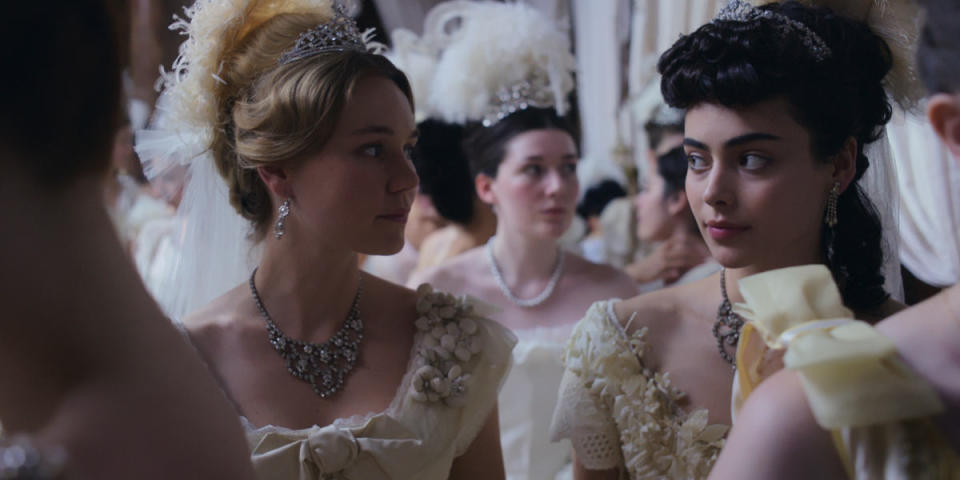
Photo: Courtesy of Apple TV+
"We didn't want period, old-looking [costumes] since the language is going to be modern," says costume designer Giovanni Lipari, who established the show's contemporary-influenced Victorian aesthetic and color palettes in the first two episodes. He also convinced the producers and Susanna White, the pilot's director, to move the timeline forward to 1880 (versus the book's 1870), as the more streamlined silhouettes and less voluminously fussy hairstyles of the decade align more with the contemporary mindset of the protagonists.
"I'd rather keep the the shape of the period, and then make a dress in denim or lurex," says Lipari, who did insist on maintaining the late 19th century's trademark bustle. He also enjoyed putting a twist on Victorian signatures, like translating the era's popular molded corset structure and basque-waist silhouette into over-layers, like vests and blazer-style riding jackets.
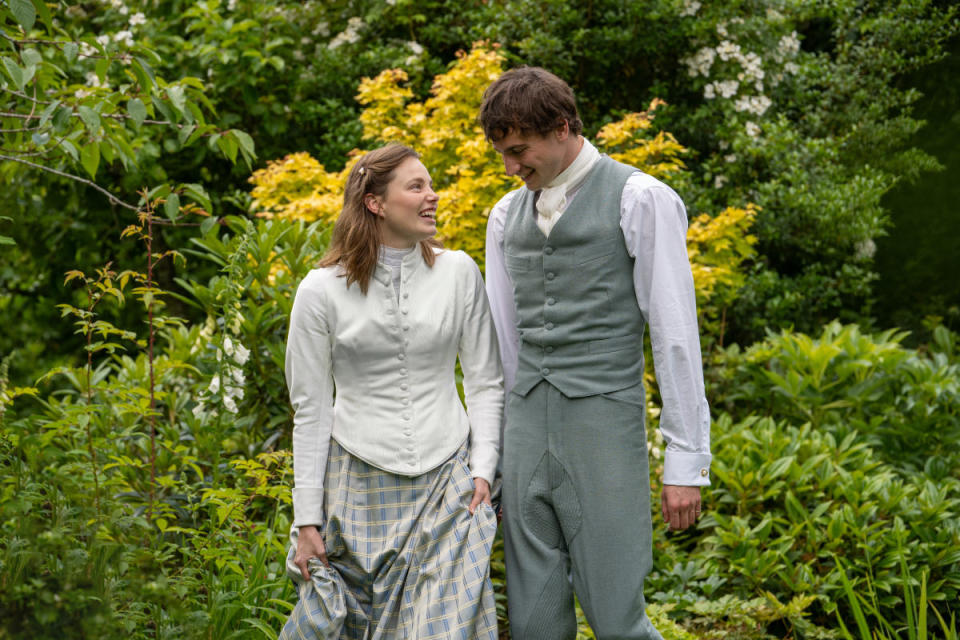
Photo: Courtesy of Apple TV+
In episode two, Conchita hosts a "girls weekend," packed with free-flowing champagne, drinking games, spontaneous (and undies-only) dips in the lake and lots of drama — because some things really are just timeless and universal. While the friends prep for a party, Jinny deconstructs her seafoam-green dress by wearing her blouse open, like a cropped jacket, and revealing a ruffle-accented blush corset and lace-trimmed bloomers underneath — an outfit that would look right at home in a Bushwick bar today. Lipari explains that those potentially scandal-inducing looks communicate White's intention of conveying the modernity of contemporary women making their own choices, which is what the Buccaneers will explore on their individual coming-of-age journeys.
"'We can be undone. We purposely want to be undone,'" he says. "In the 19th century, you would never go out without a hat or something. This is the progressive part messing with [the traditional norms]."
Ahead, Lipari takes us through the fashion in the first two episodes. (Chapters three through five were designed by Sheena Napier, while Kate Carin finishes out the series.)
Nan's 19th-Century 'Biker Jacket'
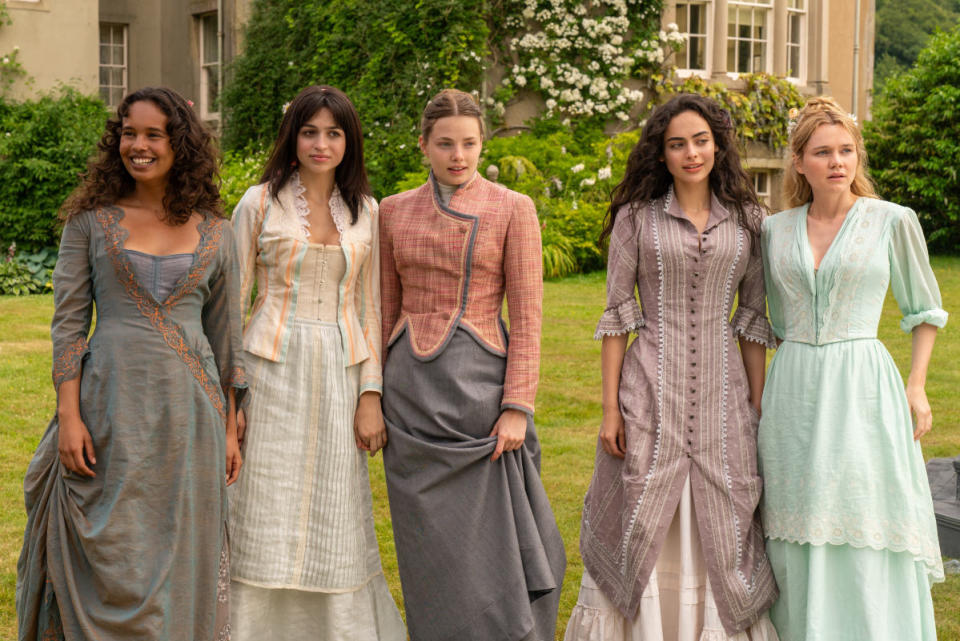
Photo: Courtesy of Apple TV+
Nan can't be bothered with the societal and familial pressure young American women from filthy-rich new-money families face to snag a land-rich but cash-poor titled English husband. But she still always manages to steal the spotlight.
"She was a bit awkward with heels and skirts — it's not really her thing," says Lipari. When Nan is obligated to wear gowns for formal occasions (or borrows one from Conchita, like in the top image), her neckline is always high and, at times, rumpled and askew.
Lipari searched for ways to evoke Nan's radical, headstrong spirit, and found an authentic 1880s asymmetrical double-breasted jacket silhouette with a sort of scalloped peplum. "It seemed almost like a biker jacket," he says. "Susanna, the director, was thrilled. I really loved it. [Nan] would be that girl."
Lipari then custom-made Nan's version in multiple colorways; the pink one, for example, was crafted out of a nubby bouclé deadstock fabric from the 1960s. He also snuck in rugged, anachronistic detailing, incorporating denim for the binding: "That would not make sense for anybody else."
Conchita's Evolving Wardrobe
Lipari wanted to differentiate Conchita — who's married to a lord and starting a family — from her friends and their life stages.
"She's already on another level," he says. "For her color scheme, we used this beautiful gray and orange. The color could be more decisive, because she's already a woman. She's a step ahead of the others, so she can be a little bit stronger within that palette."
Feeling stifled in London, Conchita tries to relax during her girls weekend in an almost boho, wrap-style iridescent gray gown, with an orange embroidered trim and the top of her corset peeking out. "She wants to be in the lightness with her girls around her, having a drink," says Lipari, who found it challenging to sartorially illustrate Conchita's next steps from her elaborately ruffled and bustled evening gowns telegraphing her "trapped" life in the city. "She goes from a salmon-pink dress with flowers and all of a sudden has a dark-red thing... The choices were more natural, more instinctive and less of a project, which was something new for us to explore in the character."
Jinny and Lizzie's Coordinating, But Conflicted, Aesthetics
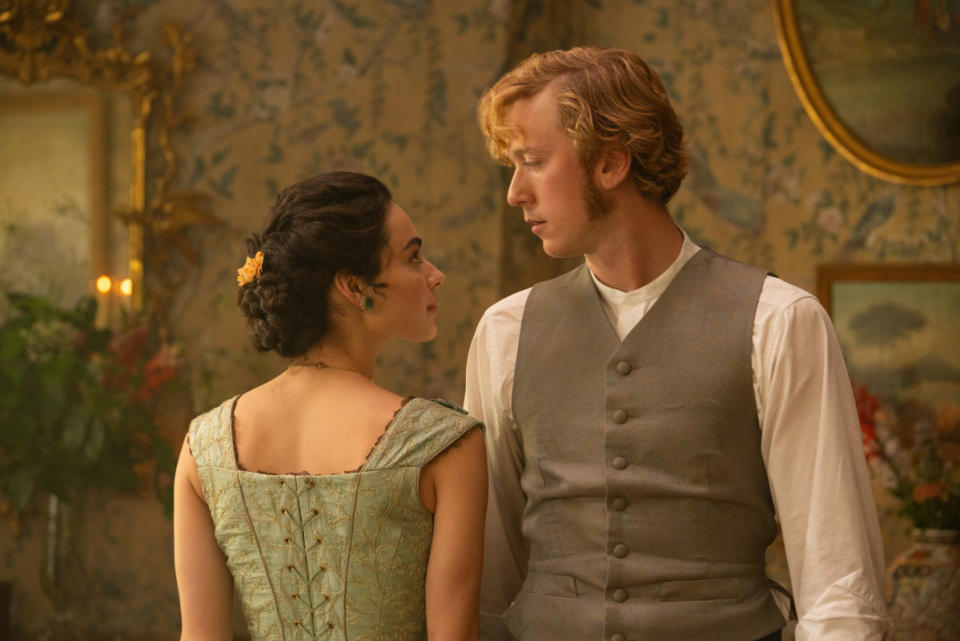
Photo: Courtesy of Apple TV+
Nan's older sister Jinny and frenemy Lizzie are the two who most represent the limited, if not negligible, opportunities and options for women in 1880: They've both been raised and conditioned to find a husband and that's all they know, but now, they're starting to question it.
"Jinny has some ambiguities — she wants one thing, then wants the other, then wants everything," says Lipari, who communicated this indecision and insecurity through "odd chromatic choices" in her hopeful dresses. "There's a tiny, little disagreement within the palette she wears," he continues, referring to a "green-y yellow" evening gown with opulent beading and bows atop each shoulder, which she wears as she anticipates partying with the posh bros. "Wouldn't you go with something more decisive to [complement] blonde hair? It's like, 'That tastes good, but I'm not sure if it's missing a bit of sugar or salt.'"
Lizzie reflects Jinny in color tones and dress choices. "They like the same men. They step on each other's toes," says Lipari. "So, sometimes, we made sure these two together, it's like they're looking at themselves in the mirror and see something different. They're not sure why they're [making their choices]."
Mabel's Chaotic Gowns
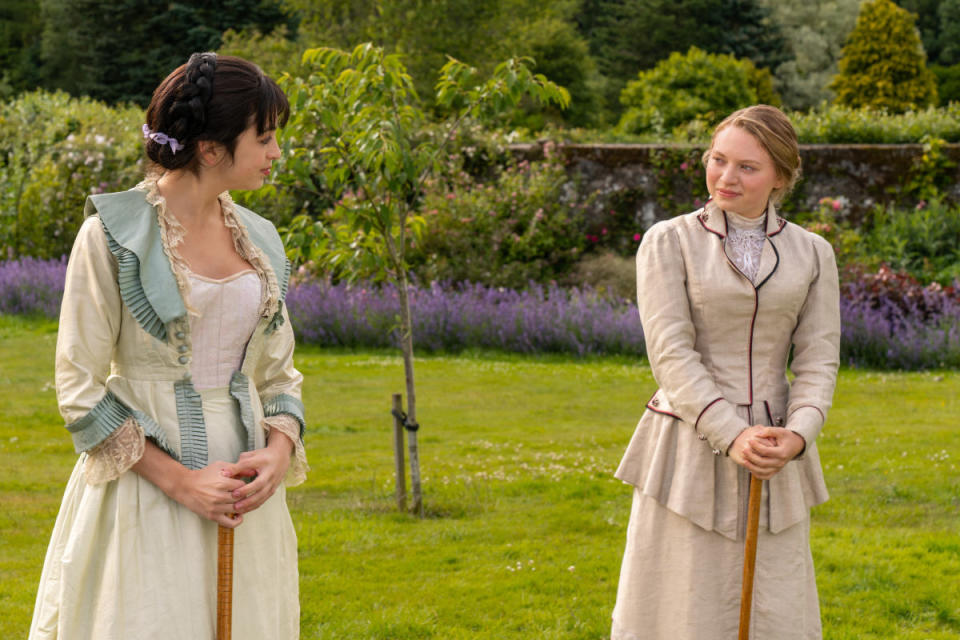
Photo: Courtesy of Apple TV+
"She seems a bit more self-isolated from the girls," says Lipari of Mabel's unexpected color combinations and near-avant garde mixture of embellishments, lace and ruffle trims.
Like Nan, she's not laser-focused on finding a man: She's on her own individual path of self-discovery with her sexuality — "so, she can make choices that don't necessarily fit into [her friends'] colors or that world," says Lipari. "That's why she's sometimes over-decorated. She's not looking in the same direction [as her friends], so she can be slightly different. She can be less harmonic."
Conchita's Anti-Deb Wedding Dress
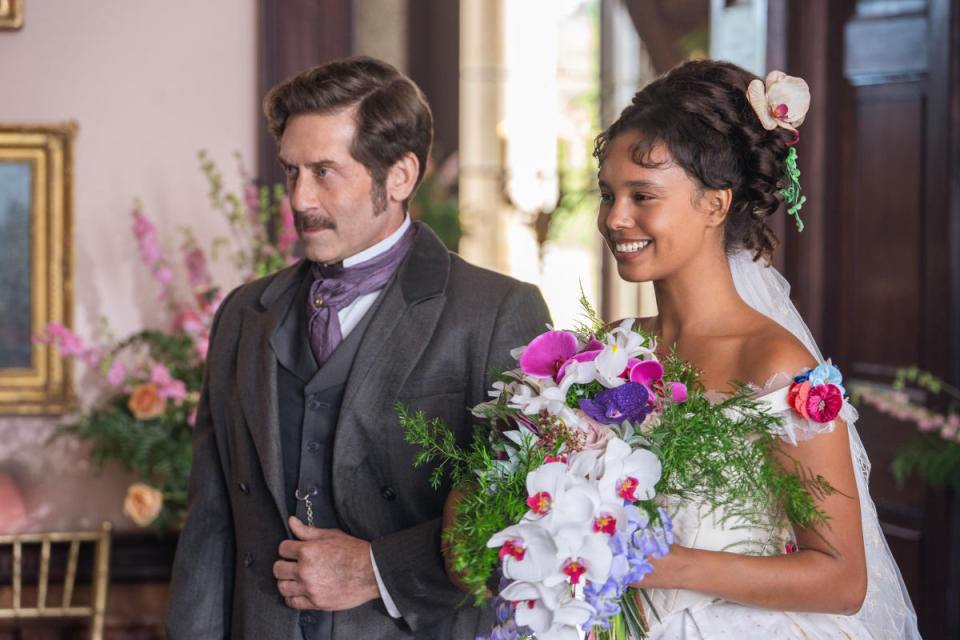
Photo: Courtesy of Apple TV+
Conchita's minimalist bridal gown feels contradictory to the "huge society wedding," Nan describes in the voiceover that opens series. All of New York City's new and old money awaits, and Conchita's family (which belongs to the former) spares no expense in exhibiting their riches through the over-the-top, flower-filled décor in the mansion. For Conchita's bridal look, Lipari also considered the extravagance of a London debutante ball.
"They wore white, off-white and all these feathers — they, literally, were decorated by their family," he says, explaining that the young women were dressed in such finery at the behest of the parents and their lofty ambitions. He realized a pared-back wedding dress would both spotlight Conchita within the excessively lavish backdrop and communicate that she ornamented herself for a life that she wants.
"The dress ended up being the most simple thing ever," says Lipari, about Conchita's clean, off-the-shoulder, basque-waist gown, with a diaphanous organza trim on the neckline, a smattering of colorful florals on the romantic cap-sleeves and a bustle leading to a flowing train. "It's really modern fashion. We forgot the 1880s. It just all of a sudden did not make sense for us anymore."
The costume designer immersed himself in a wealth of contemporary fashion references, gleaning the most inspiration from Giorgio Armani for "sharpness and simplicity," Alexander McQueen for "the ability to translate old history into new modernity" and Molly Goddard for "the lightness in use of chiffon, organza and silk tulle."
The 'Modern' Bridesmaid Dresses
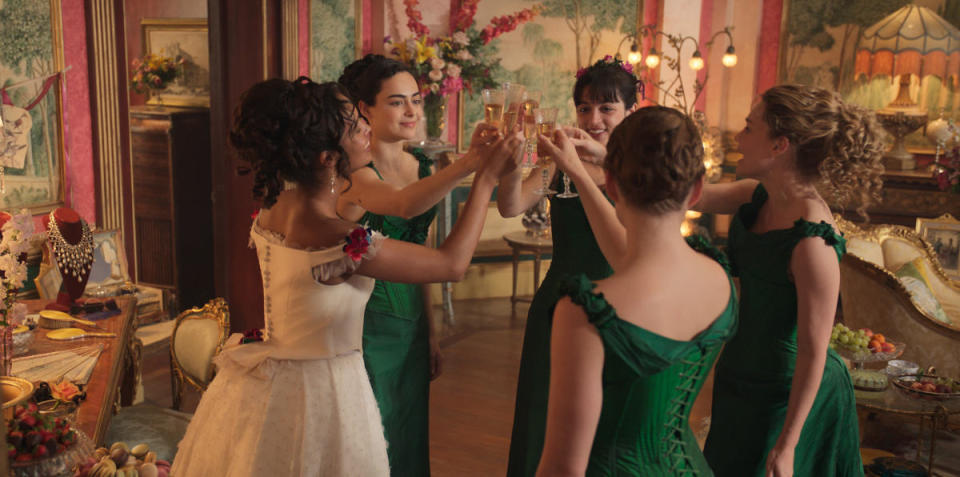
Photo: Courtesy of Apple TV+
"The bridesmaids are the thing I'm most proud of," says Lipari.
The deep emerald color choice for their dresses came from White's vision of a bold, unexpected and "brave" color for Nan, Jinny, Lizzie and Mabel. Once again, Lipari looked to another century for the silhouette, with its exquisite draping at the wide V-neckline and basque drop-waist leading to the bustle: "It's more of a 1950s style." He added another play on Victoriana with the mid-bust corsets featuring contouring mimicking whalebone strips, a single rosette atop the neckline and lace-up backs, worn as an outer-layer on the bodice.
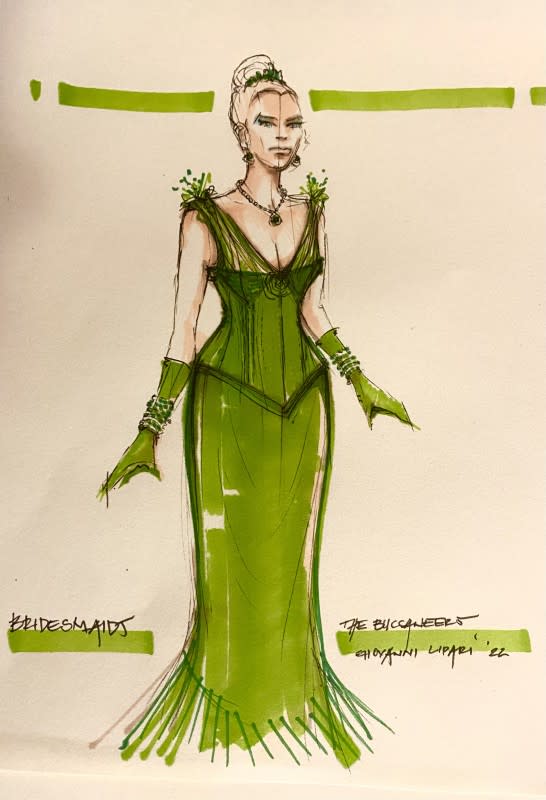
Sketch: Courtesy of Giovanni Lipari
"It was really a made-up shape and, once again, a combination of styles," says Lipari, who sartorially began a 19th century-set story of determined young women with forward-looking attitudes and mindsets. "In the end, [the dresses] feel like something a lot more modern than that."
Never miss the latest fashion industry news. Sign up for the Fashionista daily newsletter.

